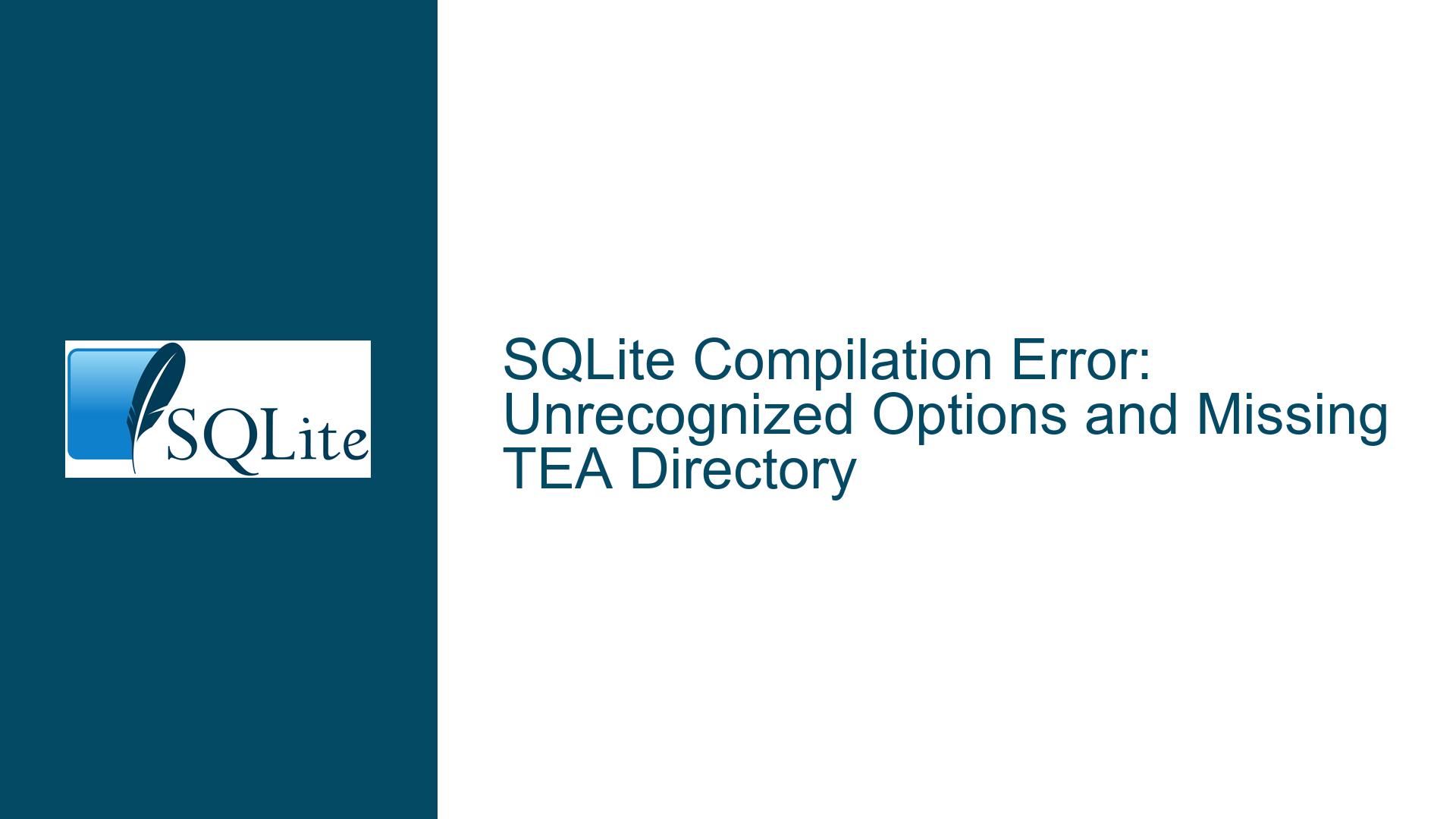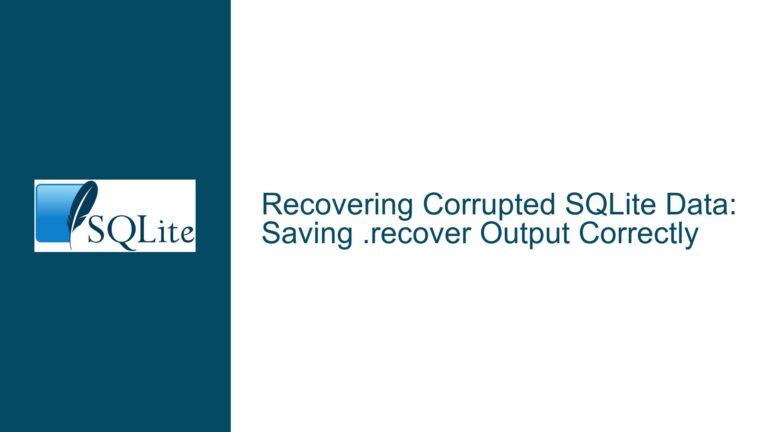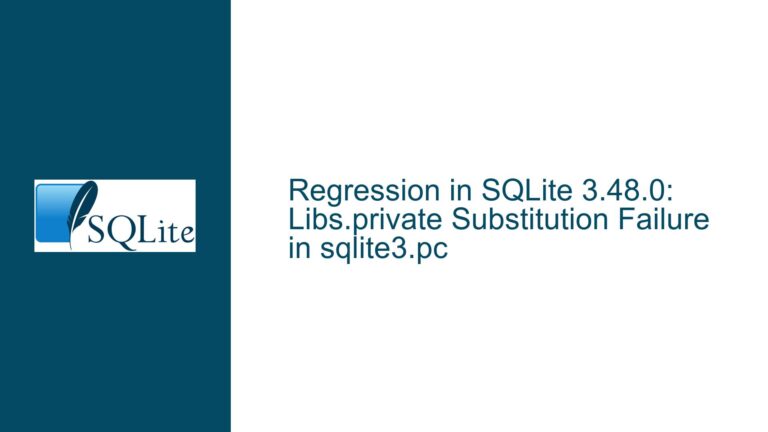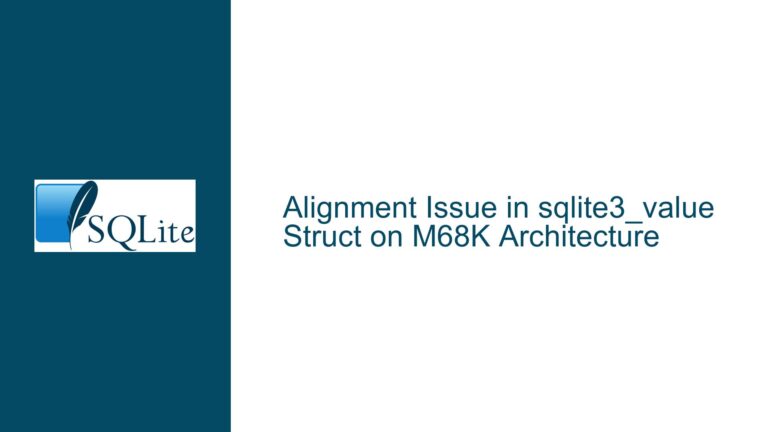SQLite Compilation Error: Unrecognized Options and Missing TEA Directory
Issue Overview: Unrecognized Configure Options and Missing TEA Directory
When attempting to compile SQLite version 3.45.0 on a Linux system, users may encounter two primary issues:
Unrecognized Configure Options: The
./configurescript may emit a warning about unrecognized options, specifically--enable-tempstore. This warning suggests that the configuration script is either outdated, misconfigured, or being run in an environment where certain options are no longer supported or have been deprecated.Missing TEA Directory: The TEA (Tcl Extension Architecture) directory, which is essential for compiling SQLite as a Tcl extension, may be missing from the unpacked source distribution. This issue typically arises when the source distribution is not unpacked correctly, leading to an incomplete directory structure. The absence of the TEA directory prevents the successful compilation of SQLite as a Tcl extension, resulting in errors related to missing
PKG_OBJECTSandPKG_LIB_FILEtargets during themakeprocess.
These issues are interconnected and often stem from an improper unpacking of the SQLite source distribution or an attempt to compile SQLite in a directory that does not match the expected structure. The following sections will delve into the possible causes and provide detailed troubleshooting steps to resolve these issues.
Possible Causes: Misconfigured Environment and Incorrect Unpacking
Misconfigured Environment:
- The
--enable-tempstoreoption, which was historically used to enable or disable the use of temporary storage in SQLite, may no longer be supported in the current version of SQLite. This could be due to changes in the build system or the removal of certain configuration options in favor of more modern alternatives. - The warning about unrecognized options may also indicate that the
./configurescript is being run in a directory that does not match the expected structure, leading to the script misinterpreting or ignoring certain options.
- The
Incorrect Unpacking of Source Distribution:
- The SQLite source distribution is typically packaged with a specific directory structure, including a
teadirectory that contains the necessary files for compiling SQLite as a Tcl extension. If the distribution is unpacked incorrectly, theteadirectory may be missing, leading to errors during the compilation process. - The absence of the
teadirectory can also cause the./configurescript to generate a Makefile that references non-existent targets, such asPKG_OBJECTSandPKG_LIB_FILE, which are essential for building the Tcl extension.
- The SQLite source distribution is typically packaged with a specific directory structure, including a
Outdated or Corrupted Source Distribution:
- If the source distribution is outdated or corrupted, it may lack the necessary files or contain incorrect configurations, leading to errors during the compilation process. This could be due to an incomplete download or an issue with the packaging of the distribution.
Troubleshooting Steps, Solutions & Fixes
Step 1: Verify the Integrity of the Source Distribution
Before proceeding with the compilation, it is essential to ensure that the SQLite source distribution has been downloaded and unpacked correctly. Follow these steps to verify the integrity of the distribution:
Check the Download: Ensure that the SQLite source distribution (
sqlite-autoconf-3450000.tar.gz) has been downloaded completely and without errors. You can verify the integrity of the downloaded file by comparing its checksum with the one provided on the SQLite website.Unpack the Distribution: Use the following command to unpack the source distribution:
tar xzf sqlite-autoconf-3450000.tar.gzThis command should create a directory named
sqlite-autoconf-3450000containing the necessary files and subdirectories, including theteadirectory.Verify the Directory Structure: After unpacking, navigate to the
sqlite-autoconf-3450000directory and verify that it contains theteadirectory. The presence of this directory is crucial for compiling SQLite as a Tcl extension.
Step 2: Reconfigure the Build Environment
If the source distribution has been unpacked correctly but the ./configure script still emits warnings about unrecognized options, follow these steps to reconfigure the build environment:
Remove Existing Configuration Files: If you have already attempted to configure the build environment, there may be residual configuration files that could interfere with the process. Remove these files using the following command:
make distcleanThis command will remove any generated configuration files and reset the build environment.
Run the Configure Script: Navigate to the
teadirectory and run the./configurescript:cd sqlite-autoconf-3450000/tea ./configureThis command will generate the necessary Makefile for compiling SQLite as a Tcl extension.
Check for Warnings: If the
./configurescript still emits warnings about unrecognized options, it may be due to an outdated or misconfigured script. In this case, consider downloading the latest version of the SQLite source distribution from the official website.
Step 3: Compile SQLite as a Tcl Extension
Once the build environment has been configured correctly, follow these steps to compile SQLite as a Tcl extension:
Run the Make Command: In the
teadirectory, run themakecommand to compile SQLite:makeThis command will compile the SQLite source code and generate the necessary binary files, including the Tcl extension.
Verify the Output: After the compilation process completes, verify that the necessary binary files have been generated. The output should include a shared library file (e.g.,
libsqlite3.soorlibsqlite3.dylib) and a Tcl extension file (e.g.,sqlite3.soorsqlite3.dll).Install the Extension: If the compilation is successful, you can install the Tcl extension using the following command:
make installThis command will install the SQLite Tcl extension to the appropriate directory, making it available for use in Tcl scripts.
Step 4: Address Unrecognized Configure Options
If the ./configure script continues to emit warnings about unrecognized options, such as --enable-tempstore, follow these steps to address the issue:
Review the Configure Script: Open the
configurescript in a text editor and search for the--enable-tempstoreoption. If the option is commented out or no longer supported, remove it from any custom configuration flags you may be using.Update Configuration Flags: If you are using custom configuration flags, ensure that they are up-to-date and compatible with the current version of SQLite. For example, the
--enable-tempstoreoption may have been replaced by a different option or removed entirely.Re-run the Configure Script: After updating the configuration flags, re-run the
./configurescript to generate a new Makefile:./configureThis should eliminate any warnings about unrecognized options and ensure that the build environment is configured correctly.
Step 5: Troubleshoot Missing TEA Directory
If the tea directory is missing from the unpacked source distribution, follow these steps to troubleshoot the issue:
Re-download the Source Distribution: If the
teadirectory is missing, it may be due to an incomplete or corrupted download. Re-download the SQLite source distribution from the official website and unpack it again using thetar xzfcommand.Verify the Unpacking Process: Ensure that the source distribution is unpacked correctly by checking the directory structure. The
teadirectory should be present in thesqlite-autoconf-3450000directory.Manually Create the TEA Directory: If the
teadirectory is still missing, you can manually create it and copy the necessary files from the SQLite source distribution. However, this is not recommended unless you are familiar with the SQLite build system and can ensure that all necessary files are present.Contact SQLite Support: If the
teadirectory is consistently missing from the source distribution, it may indicate an issue with the packaging of the distribution. In this case, consider contacting SQLite support or reporting the issue on the SQLite forum.
Conclusion
Compiling SQLite from source can be a straightforward process if the source distribution is unpacked correctly and the build environment is configured properly. However, issues such as unrecognized configure options and missing directories can complicate the process. By following the troubleshooting steps outlined above, you can resolve these issues and successfully compile SQLite as a Tcl extension. Always ensure that you are using the latest version of the SQLite source distribution and that your build environment is properly configured to avoid common pitfalls.






